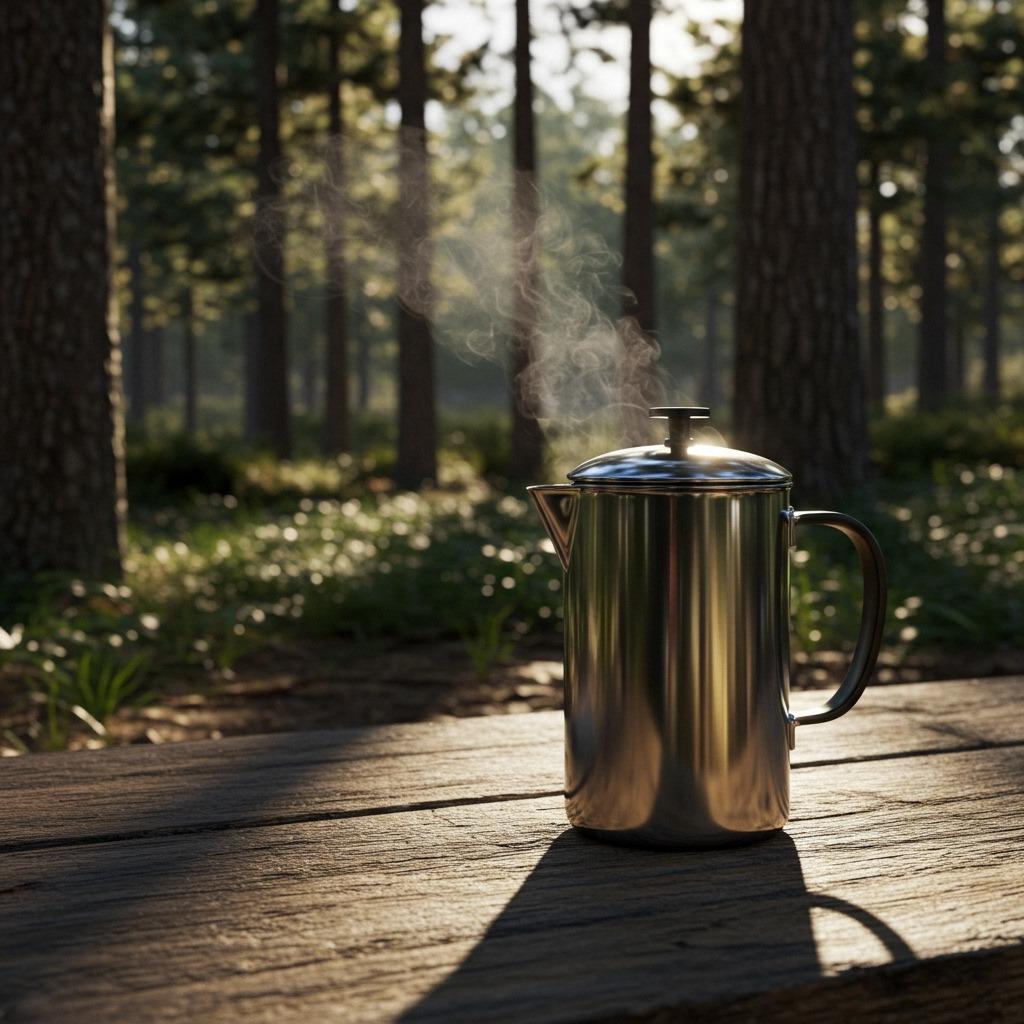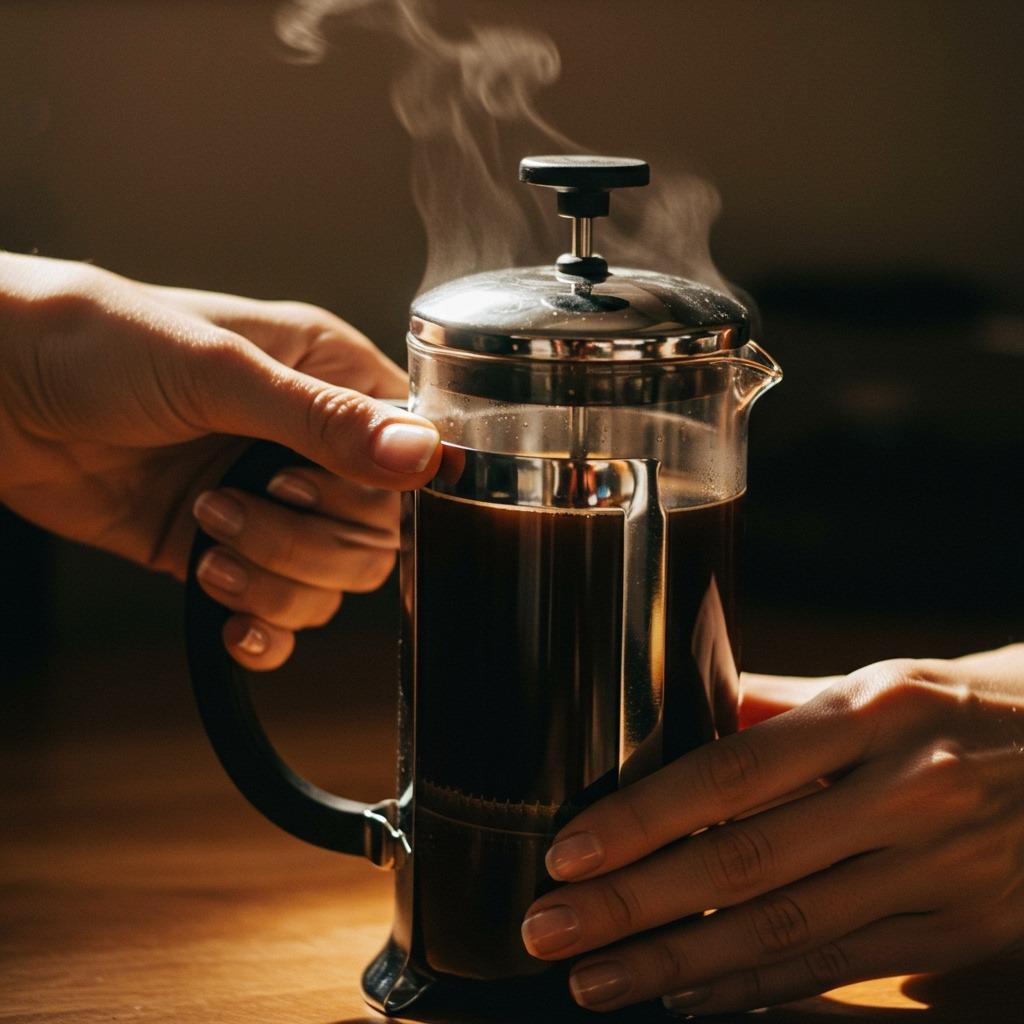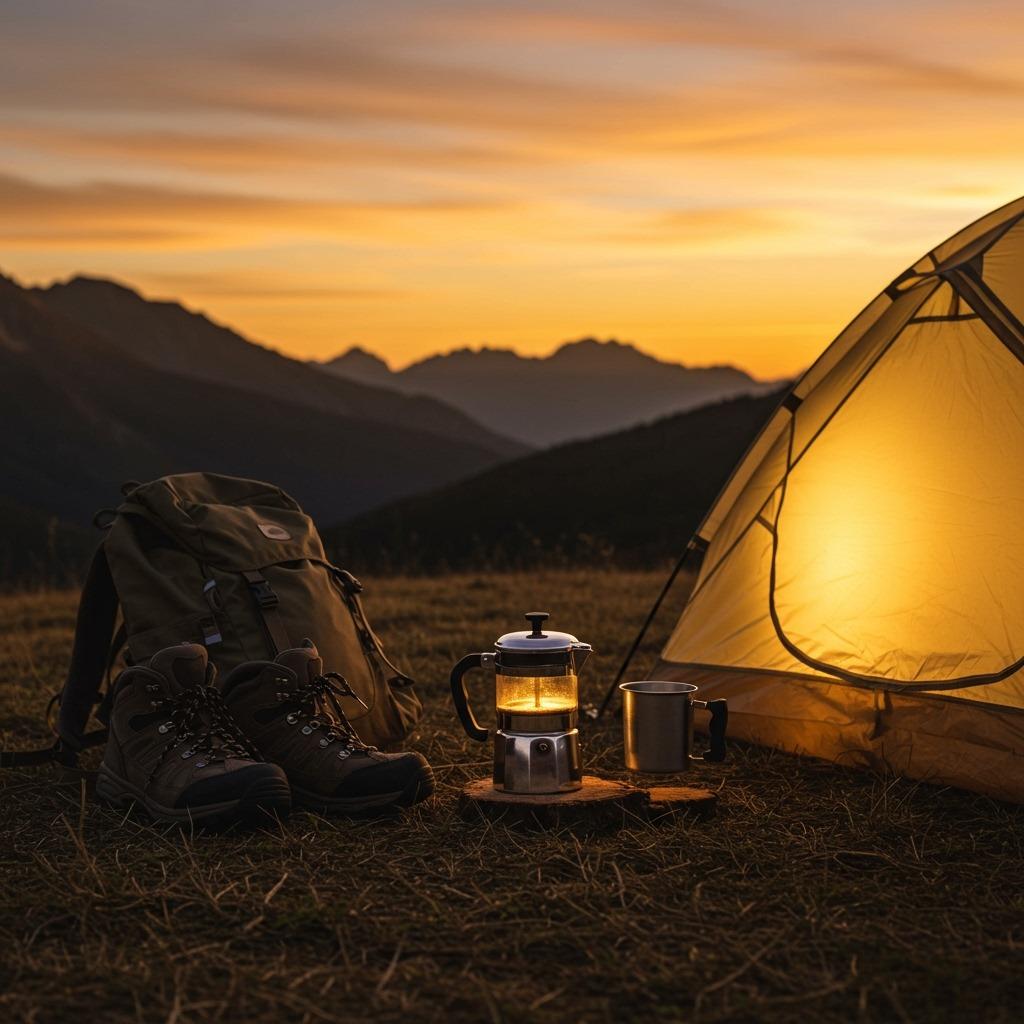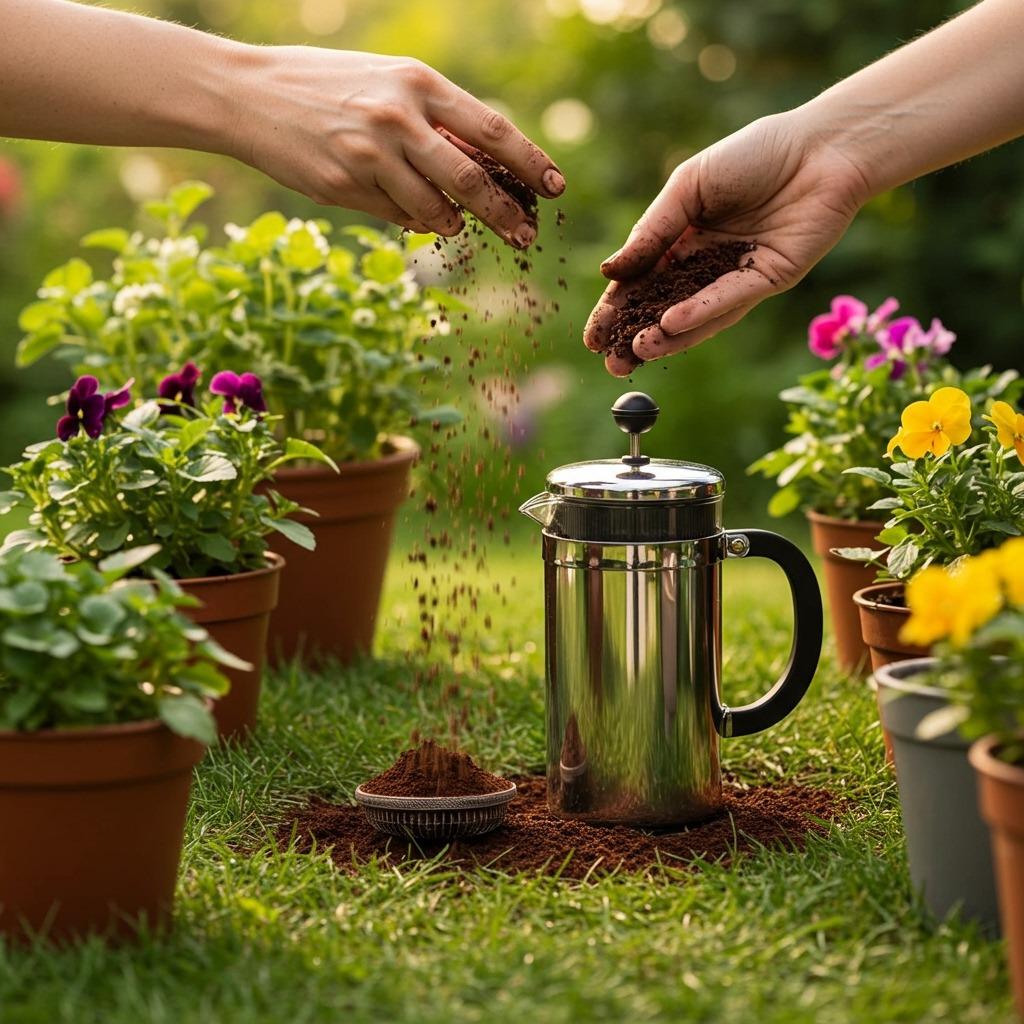That first morning at base camp in Glacier National Park, watching steam rise from my French press while grizzly tracks dotted the shoreline nearby—that’s when I truly understood why this simple brewing method has captivated coffee lovers for decades. No electricity, no fancy gadgets, just hot water, coarsely ground beans, and four minutes of patience. The result? Rich, full-bodied coffee that makes instant seem like a cruel joke.
Whether you’re brewing at 10,000 feet or in your kitchen, mastering the French press connects you to coffee’s essential simplicity. Before heading into the wilderness, make sure you’re fully prepared with our comprehensive camping for beginners guide to set up your perfect outdoor coffee station.
Why French Press Makes Perfect Outdoor Coffee
French press brewing delivers something no other camp coffee method can match: full immersion extraction. Unlike drip coffee, where water briefly contacts grounds, French press allows complete saturation for four minutes, pulling oils and flavors that paper filters would trap.
This creates coffee with remarkable depth—rich body, complex flavors, and that satisfying heaviness on your tongue that makes you pause mid-sip and appreciate the moment. For outdoor enthusiasts, it’s practically bulletproof: no breakable parts (if you choose stainless steel), no filters to forget, and consistent results whether you’re brewing at sea level or alpine elevations.

Essential Gear for French Press Success
The beauty lies in simplicity—you need surprisingly little to brew exceptional coffee anywhere.
Choosing Your French Press
Stainless Steel Models: Virtually indestructible for camping, excellent heat retention, dishwasher safe. The Stanley Adventure and GSI Outdoors Java Press are trail favorites.
Glass French Presses: Beautiful at home, easy to clean, let you watch the brewing process. Bodum Chambord is the classic choice, but pack carefully for camping.
Insulated Versions: Keep coffee hot longer, perfect for leisurely morning routines. Espro P7 offers superior filtration with double-wall construction.
Coffee Grinding Equipment
Manual Burr Grinders: No electricity needed, consistent results, compact for packing. Hario Skerton Pro and JavaPresse models are reliable trail companions.
Pre-Ground Strategy: If grinding isn’t possible, buy beans ground specifically for French press (coarse) and use within one week for best flavor.
Water Heating Methods
Any heat source works: camp stoves, wood fires, stovetop kettles, or electric kettles. Gooseneck kettles offer superior pouring control but aren’t essential.
Precision Tools
Digital Scale: Consistent coffee-to-water ratios make the difference between good and exceptional coffee. Waterproof models work best for outdoor use.
Timer: Most phones work fine, though dedicated brewing timers prevent distractions during critical steeping phases.
The Perfect French Press Recipe
After countless mornings perfecting this method both in kitchens and around campfires, here’s the foolproof formula:
Basic Ratio and Measurements
Start with a 1:15 coffee-to-water ratio—one gram of coffee per fifteen grams of water. For a standard 34-ounce French press, use 56 grams of coarsely ground coffee (about 8 tablespoons) with 850 grams of hot water.
Step-by-Step Brewing Process
Step 1: Heat Water Properly
Bring water to a rolling boil, then let it cool for 30 seconds. Target temperature: 195-205°F. Without a thermometer, the 30-second rule works perfectly.
Step 2: Preheat Your French Press
Pour hot water into the empty press, swirl briefly, then dump out. This prevents temperature shock and maintains brewing heat.
Step 3: Add Coffee Grounds
Add coarsely ground coffee to the warmed, empty press. Grounds should resemble coarse sea salt or breadcrumbs—never fine powder.
Step 4: Initial Water Addition
Pour hot water to about half the press capacity. Stir gently once with a wooden spoon to ensure all grounds are saturated.
Step 5: Complete the Fill
Add remaining hot water, leaving about one inch of space at the top. Place the lid with the plunger fully extended to create a heat-retaining seal.
Step 6: Steep Time
Wait exactly 4 minutes. This timing extracts optimal flavors without over-extraction, which creates bitterness.
Step 7: Press and Serve
Slowly press the plunger down with steady pressure for over 15-30 seconds. Serve immediately to prevent over-extraction.
For fellow outdoor enthusiasts who appreciate morning rituals, pair your perfect French press with ideas from our camping breakfast ideas guide for complete wilderness dining.

Coffee Selection for French Press Excellence
Bean choice dramatically impacts your final cup. The French press’s full immersion method favors certain characteristics.
Roast Level Recommendations
Medium Roasts: Offer balanced acidity and sweetness that complement the French press’s full-body extraction. Brazilian and Colombian beans shine here.
Medium-Dark Roasts: Provide chocolatey, nutty notes that create satisfying richness without overwhelming oils.
Avoid Light Roasts: Can become overly acidic with full immersion, though some single-origins work if you prefer brightness.
Grind Size: The Critical Factor
Coarse grounds are non-negotiable. Too fine creates muddy, over-extracted coffee that passes through the metal filter. Too coarse under-extracts, resulting in weak, sour coffee that wastes good beans.
Test your grind: properly coarse coffee should feel gritty between your fingers, similar to kosher salt crystals.
Bean Freshness and Storage
Use beans roasted within 2-4 weeks for optimal flavor. Store whole beans in airtight containers, away from light and heat. For camping, consider vacuum-sealed bags that protect beans during transport.
According to coffee experts at James Hoffmann, proper bean selection and storage significantly impact French press brewing success, especially in outdoor environments where temperature and humidity fluctuations affect extraction.
Troubleshooting Common French Press Problems
Even experienced brewers encounter issues. Here’s how to diagnose and fix problems:
Muddy or Gritty Coffee
Symptoms: Sediment in your cup, unpleasant texture
Causes: Grounds too fine, damaged filter, pressing too aggressively
Solutions: Use a coarser grind, inspect the filter for damage, press more slowly and gently
Weak or Sour Coffee
Symptoms: Watery taste, sharp acidity, lack of body
Causes: Under-extraction from coarse grounds, cool water, and short steeping
Solutions: Try slightly finer grind, hotter water, or extend steeping to 5 minutes
Bitter Coffee
Symptoms: Harsh aftertaste, overwhelming intensity
Causes: Over-extraction from fine grounds, too-hot water, and extended steeping
Solutions: Coarser grind, cooler water (190-195°F), shorter steep time (3 minutes)
Difficult Pressing
Symptoms: Plunger won’t move or requires excessive force
Causes: Grounds too fine, too much coffee, clogged filter
Solutions: Coarser grind, reduce coffee amount, clean filter thoroughly
Temperature Loss
Symptoms: Coffee cools too quickly during brewing
Causes: Heat loss from uninsulated equipment, cold environment
Solutions: Preheat everything, use an insulated press, brew in a sheltered location
Advanced French Press Techniques
Once you master the basics, these methods can elevate your brewing:
The James Hoffmann Method
This technique reduces sediment and creates cleaner cups:
- Add coffee and water, stir once gently
- After 4 minutes, stir the surface three times.
- Use two spoons to remove floating foam and ground.s
- Wait 5-8 additional minutes for the grounds to settle.
- Pressthe plunger gently just to the surface level—don’t push the grounds down.
Cold Brew French Press
Perfect for hot camping days:
- Use the same 1:15 ratio with room temperature water
- Steep 12-24 hours depending on desired strength
- Press gently and serve over ice
- Results in smooth, low-acid coffee concentrate
Altitude Adjustments
At high elevation, adjust your technique:
- Water boils at lower temperatures, so don’t let it cool as long
- Thinner air may require slightly longer steeping times
- Wind affects heating consistency—use windscreens around stoves
If you’re planning high-altitude adventures, our guide on how to train for high-altitude hiking includes preparation tips that complement outdoor coffee brewing skills.

Maintenance and Care for Longevity
Proper maintenance ensures years of excellent coffee and prevents off-flavors.
Daily Cleaning Routine
Immediate Rinse: Clean with hot water immediately after use. Coffee oils turn rancid quickly, affecting taste.
Disassembly: Remove plunger assembly and wash all components separately with warm, soapy water.
Thorough Drying: Air dry completely before storage to prevent mold and bacteria growth.
Weekly Deep Cleaning
Baking Soda Solution: Soak all parts in warm water with 2 tablespoons of baking soda for 15 minutes.
Scrub Gently: Use a soft brush to remove oil buildup from all surfaces.
Filter Inspection: Check the metal filter for damage—bent or torn filters let grounds through.
Camping-Specific Care
Pack Protection: Use padded cases for glass models, or choose stainless steel for durability.
Water Quality: Filter water when possible to prevent mineral buildup in remote locations.
Storage: Keep completely dry during multi-day trips to prevent mold growth.
French Press vs Other Brewing Methods
Understanding comparisons helps you choose the right method for different situations:
French Press vs Pour Over
French Press: Fuller body, easier technique, better for groups, no paper filters needed
Pour Over: Cleaner flavors, more control over extraction, requires more attention and technique.
French Press vs Drip Coffee
French Press: Richer flavors, no electricity needed, portable, makes smaller quantities
Drip Coffee: More convenient for daily use, keeps warm longer, makes larger batches
French Press vs Espresso
French Press: Larger quantities, gentler caffeine delivery, more forgiving technique
Espresso: Concentrated intensity, requires expensive equipment, faster preparation
For comprehensive brewing method comparisons and coffee science, Serious Eats offers a detailed analysis of extraction principles and technique variations.
Regional French Press Variations
Coffee culture worldwide has adapted French press brewing to local preferences:
European Tradition
In France, the “cafetière à piston” often accompanies breakfast pastries, served in large bowls rather than cups for a leisurely morning ritual.
Scandinavian Style
Nordic countries embrace the French press for its ability to showcase light-roasted, single-origin coffees that highlight terroir and processing methods.
American Camping Culture
U.S. outdoor enthusiasts have adopted the French press as the definitive camp coffee method, valuing its durability and consistent results in wilderness conditions.
Third Wave Adaptations
Specialty coffee shops use a French press for “cupping”—professional coffee tasting—because it provides the cleanest representation of bean characteristics.
Environmental Impact and Sustainability
French press brewing offers significant environmental advantages:
Zero Waste Benefits
- No paper filters or plastic pods
- Durable equipment lasts decades with proper care.
- Coffee grounds make excellent garden compost.
- Minimal energy requirements compared to electric methods
Leave No Trace Principles
When camping, dispose of grounds responsibly:
- Scatter used grounds away from water sources and campsites
- In high-impact areas, pack out grounds with other organic waste.
- Never dump grounds directly into streams or lakes.
Supporting Sustainable Coffee
French press brewing showcases single-origin, direct-trade coffees that support farming communities and environmental stewardship.

Building Your French Press Coffee Ritual
The best part isn’t just the coffee—it’s the mindful ritual that creates anticipation and connection.
Morning Routine Development
Create consistent habits that become meditative:
- Grind beans while the water heats, enjoying the aroma
- Use steeping time for stretching or planning your day.
- Savor that first sip while watching the sunrise or reading.
- Clean equipment immediately to maintain the ritual.
Camping Traditions
French press brewing becomes magical outdoors:
- The sound of water boiling over a camp stove
- Coffee aroma mixing with pine-scented morning air
- That first perfect sip while watching wildlife or sunrise over peaks
- Sharing exceptional coffee with fellow adventurers
For complete outdoor preparation that includes perfect coffee rituals, our What to Pack for Hiking guide covers all essentials for successful wilderness adventures.
Pairing French Press Coffee with Food
The rich, full body of French press coffee complements various foods:
Breakfast Combinations
- Buttery pastries: Croissants and Danish pair beautifully with coffee’s oils
- Hearty proteins: Eggs, bacon, and sausage balance coffee’s richness
- Sweet options: Pancakes, French toast, and maple syrup create delicious contrasts
Camping Meals
- Trail mix: Nuts and dried fruit complement coffee’s earthiness
- Oatmeal: Steel-cut oats with berries and coffee create satisfying mornings
- Campfire treats: S’mores and coffee around evening fires end perfect days.
Seasonal Pairings
- Spring/Summer: Lighter breakfast items, fresh fruits, yogurt
- Fall/Winter: Hearty soups, warm breads, comfort foods that match coffee’s richness
For comprehensive outdoor cooking guidance, REI’s Expert Advice provides tested recipes and meal planning strategies for wilderness adventures.
Frequently Asked Questions About French Press Coffee
Q1: What’s the ideal coffee-to-water ratio for French press?
The standard ratio is 1:15 (1 gram of coffee per 15 grams of water), which equals roughly 2 tablespoons of coffee per 6 ounces of water. Start here and adjust based on taste preference—use more coffee for a stronger brew, less for a milder coffee. Consistency in measurement creates repeatable results.
Q2: How coarse should I grind coffee beans for a French press?
Grind coffee to a coarse consistency resembling sea salt or breadcrumbs. The grounds should feel gritty between your fingers, never powdery. If the grounds are too fine, they’ll pass through the metal filter and create muddy coffee. Too coarse results in weak, under-extracted coffee.
Q3: How long should I steep French press coffee?
Four minutes is the standard steeping time for most coffee types and roast levels. You can adjust based on taste: longer steeping (up to 6 minutes) creates stronger, more extracted coffee, while shorter steeping (3 minutes) produces lighter, less intense coffee. Consistency in timing helps perfect your personal preference.
Q4: Why does my French press coffee taste bitter?
Bitter coffee typically results from over-extraction caused by grinding too fine, steeping too long, using water that’s too hot (over 205°F), or using too high a coffee-to-water ratio. Try using coarser grounds, shorter steep time (3 minutes), or cooler water (195°F) to reduce bitterness.
Q5: Can I make cold brew in a French press?
Absolutely! Use the same 1:15 coffee-to-water ratio but with room temperature or cold water. Steep for 12-24 hours, depending on desired strength, then press and serve over ice. Cold brew French press creates smooth, low-acid coffee that’s perfect for hot weather camping or home brewing.
